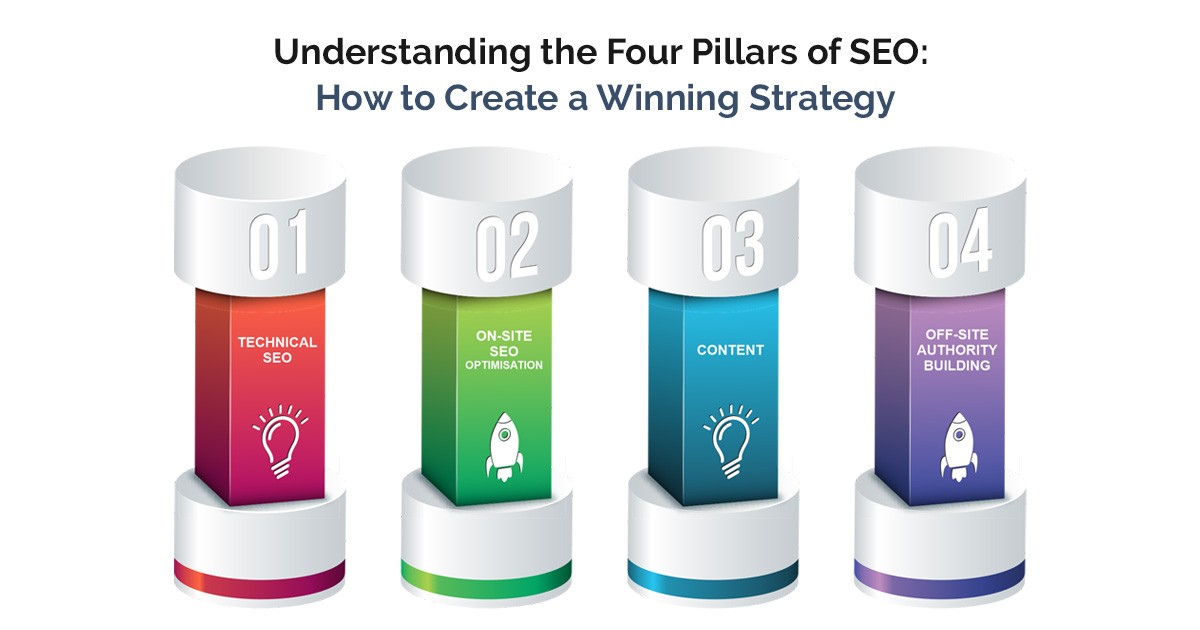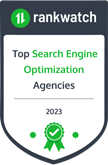
Search engine optimisation, or SEO, is essential to a successful online strategy. It helps to ensure that potential customers can find you online easily — otherwise, all the hard work you’ve put into building your website is for naught. Though it may seem complex at first glance, breaking down and creating a plan around the four SEO pillars helps achieve success.
The four pillars of SEO are: technical SEO, on-page SEO, content marketing and off-page SEO.
Technical SEO refers to the aspects of your website in order for it to be properly recognised by search engine robots. This includes site structure and HTML tags, page loading speed, and mobile page loading behaviour.
On-page SEO involves making sure that all relevant content on your pages, such as titles and meta descriptions, attracts visitors’ attention in the search results.
Content marketing focuses less on ranking factors but still holds substantial importance; providing interesting, informative, or entertaining content makes visitors more likely to stay longer on your website and interact with it in some way.
Finally, off-page SEO helps build trust with search engines by linking back from websites owned by authoritative sources in your niche or related fields – this is considered one of the most vital possible signals.
Nailing down your SEO strategy starts with understanding the four pillars. Let us discuss these four pillars of SEO and how you can use them to improve your website rankings and visibility!

The four pillars of SEO
-
Technical SEO
Technical SEO can appear overwhelming for those unfamiliar with the world of web development, but with a little knowledge and research, it’s quite easy to manage. At its core, technical SEO is about ensuring that search engines are able to read, explore, index and rank your website accurately.
To tackle this, you’ll need to understand how your site is being seen by search engines and this requires the use of tools such as Screaming Frog and Deep Crawl.
These tools will help determine the key technical areas where potential problems may be found.
From crawlability – ensuring that search bots can find your site – through to making sure pages are properly indexed and optimising mobile performance, addressing any issues can help boost organic visibility and improve the user experience at the same time.
It is also essential to ensure that you have a fully secure HTTPS connection, as this will likely become more important over time due to Google’s commitment to promoting safe browsing experiences for users.
By taking a proactive approach to Technical SEO, you can ensure search engines understand your content correctly without hindering online success
-
On-site SEO optimisation
On-site SEO optimisation is an essential part of any successful website. All aspects of your page should be optimised to target your desired audience and search engine robots. Starting with a well-structured content hierarchy allows you to make sure the main areas are well-organised and identified.
When optimising for on-site SEO, keyword research is a critical factor in understanding how potential customers view the language used on your site. To supplement that, ensure each URL is simple and descriptive, giving search engines important information about what the page contains to allow them to index it correctly.
Once that’s done, use smart optimisation tactics when creating content to target aspects such as images and titles to focus on customer searches. When all of these elements come together, it gives you an incredibly powerful toolset to maximise organic search traffic.
-
Content
Content plays an integral part in any website, large or small. Whether it’s a blog post, an eCommerce page, or an information page, content helps users learn more about the subject. It’s also the main driving force behind conversions because when customers are informed and educated on what makes your business unique, they’re more likely to take the desired action.
Content is essential for ensuring that customers understand who you are and what you do and how using your service will help them reach their goals.
Beyond informing potential customers about your product or service, great content should capture potential leads and guide them through sales. Rather than relying solely on flashy visuals and marketing gimmicks, focus on delivering quality content that engages with visitors and provides educational resources throughout their experience of interacting with promotional materials.
Quality content should provide users with clear explanations of why choosing your services is beneficial to them. As such, regularly updating content to reflect current times accurately can increase customer engagement even further. Read on our blog about How to Reuse and Repurpose Your Old Blog Content)
-
Off-site authority building
Link building is one of the most important tactics SEO practitioners use to build off-site authority. Link building helps search engines’ algorithms understand which pages of your website are credible and authoritative, making them more likely to appear in organic search engine results.
It is important to approach link-building with a positive philosophy and ensure all links come from credible sources. Links should be placed thoughtfully, connecting related pieces of content that give readers extra context or additional information on their searches.
The late Eric Ward, an SEO pioneer, aptly summarised this mindset best when he said, “Connect what should be connected.”
When doing link building, it is equally important to avoid placing unhelpful links in irrelevant websites. Linking to unrelated websites can result in penalties by search engine algorithms and damage your credibility online.
Because the way link algorithms work is intricate and constantly changing, webmasters must keep up with the ever-changing trends to not miss out on key opportunities for healthy, contextual link building.
When done correctly, off-site authority building can prove immensely valuable for an organisation’s visibility in organic search engine results.
The Bottom Line!
Search engine optimisation (SEO) is important to any business’s online presence. By understanding how search engines determine the rankings and visibility of your site, you can use SEO to maximise its effectiveness.
At its core, SEO is made up of four key pillars – content, technical, on-page and off-page strategies. These pillars are designed to help create a comprehensive framework covering all SEO best practices.
Content is at the heart of any good SEO strategy as it speaks directly to what users will be looking for when they search. As such, content should include keywords that accurately reflect the page’s purpose as well as valuable information for the user that isn’t drowned out by unnecessary keyword stuffing.
Technical factors focus more on the website itself than on user-facing elements such as ensuring that pages are indexed and crawlable.
On-page strategies involve ensuring proper structure and formatting within the website. At the same time, off-page factors dig into link-building activities with relevant external sites that can drive qualified traffic back to your own site.
By implementing each pillar within an SEO strategy, businesses can ensure their websites reach maximum potential and position higher in search engine rankings which will help increase organic traffic from interested users.
For a detailed overview of each pillar of SEO, read the following:
- Pillar 1 of The Four Pillars of SEO: Technical SEO
- Pillar 2 of The Four Pillars of SEO: On-site SEO Optimisation
- Pillar 3 of The Four Pillars of SEO: Content
- Pillar 4 of The Four Pillars of SEO: Off-Site Authority Building
Suggested Read: Must-Know Strategies For Optimising Your Site With Google And SEO Tools

